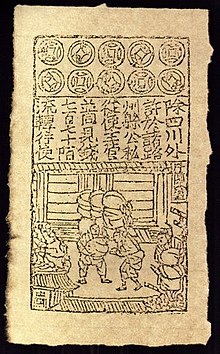
Back Jiaozi (moneda) Catalan Jiaozi (moneda) Spanish Jiaozi (monnaie) French Jiaozi (mata uang) ID 交子 Japanese 교자 (지폐) Korean Jiaozi Dutch Jiaozi (valuta) NB Jiaozi Slovenian Jiaozi Uzbek

| Jiaozi | |||||||||||
|---|---|---|---|---|---|---|---|---|---|---|---|
| Chinese | 交子 | ||||||||||
| |||||||||||
Jiaozi (Chinese: 交子) was a form of promissory note which appeared around the 11th century in the Sichuan capital of Chengdu, China. Numismatists regard it as the first paper money in history, a development of the Chinese Song Dynasty (960–1279 CE). Early Jiaozi notes did not have standard denominations but were denominated according to the needs of the purchaser and ranged from 500 wén to 5 guàn. The government office that issued these notes or the Jiaozi wu (Chinese: 交子務) demanded a payment or exchange fee (Chinese: 紙墨費) of 30 wén per guàn exchanged from coins to banknote. The Jiaozi were usually issued biannually.[1] In the region of Liang-Huai (Chinese: 兩淮) these banknotes were referred to as Huaijiao (淮交) and were introduced in 1136. Still, their circulation stopped quickly after their introduction. Generally the lower the denominations of the Jiaozi the more popular they became, and as the government was initially unable to regulate their production properly, their existence eventually led to undesirably high inflation rate.
To combat counterfeiting, jiaozi were stamped with multiple banknote seals.[2]
- ^ "Paper Money in Premodern China.". ChinaKnowledge.de - An Encyclopaedia on Chinese History, Literature and Art. May 10, 2016. Retrieved February 6, 2018.
- ^ "The first Chinese paper money, "jiaozi," was stamped with six different inks and multiple banknote seals". Brad Smithfield (The Vintage News). May 18, 2017. Retrieved February 14, 2018.